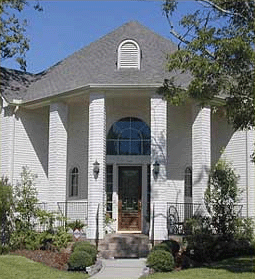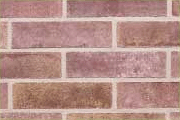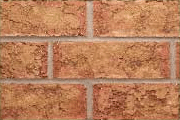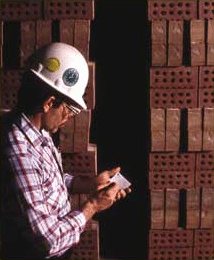A Brick, is a Brick, is a Brick...Or is it?
 Masonry has the reputation among many consumers as being a high commodity item. Some consumers may decide to turn to siding and other cheaper, but less durable, materials; others will hold out that their dream of owning a well-built, long-lasting masonry home will come true, as well as within their price range.
Masonry has the reputation among many consumers as being a high commodity item. Some consumers may decide to turn to siding and other cheaper, but less durable, materials; others will hold out that their dream of owning a well-built, long-lasting masonry home will come true, as well as within their price range.
Over the years, the industry has discussed the possibilities they can pursue to keep masonry on the walls of buildings, thereby bringing steady work for mason contractors and their crews. There's been talk of keeping masonry competitive with other systems, creating new innovations, introducing certifications, and dozens of other options across the board to raise the market share of masonry in the U.S. building industry.
Many times, options and introductions for new ways of doing things for the good of the whole industry can lead to a decline in market share for certain members of the group. For instance, there are some in the masonry manufacturing industry who feel that the introduction of concrete brick is taking market share from clay brick manufacturers. While that is one way to look at it, others feel that concrete brick is just one more option to keep masonry on buildings, when the consumer could have gone with a non-masonry product instead.
Masonry discussed this topic with two manufacturers: Acme Brick Company, whose products include clay brick; and Hanson Brick, which produces both concrete and clay brick, among other items.
Material Differences
The material differences between clay and concrete brick are as varying as the colors, shapes and sizes that are offered. Here are two of the differences that Acme Brick and Hanson Brick discussed.
Colors & Textures
While both options come in a wide variety of colors, there are advantages of one over the other. Both parties agree that, while concrete brick is able to achieve many more of the lighter, pastel colors, clay brick is more capable of reaching the deeper reds and browns.
 "Concrete brick is produced in some unique colors that can be used as an architectural accent to clay brick," says Simon Bates, Commercial President of Hanson Brick. "Clay brick also has a beautiful range of colors ? especially old world heritage colors ? that can't be found in a concrete product."
"Concrete brick is produced in some unique colors that can be used as an architectural accent to clay brick," says Simon Bates, Commercial President of Hanson Brick. "Clay brick also has a beautiful range of colors ? especially old world heritage colors ? that can't be found in a concrete product."
"Colorwise, you can't get the deep reds and deep browns with concrete brick, " says Bill Seidel, Vice President of Marketing for Acme Brick Company. "And texture, too. You can put some beautiful texture on a clay brick because it's so pliable. You just can't get that texture on concrete brick. It's just a totally different product."
While concrete brick comes in a variety of colors not available in the clay variety, there's the age old question about concrete's color longevity.
"We really aren't aware of any pigment that's added to concrete that won't fade over time," explains Seidel. "We're in that business, so we know that.
"With the clay product, the color is throughout the unit," he adds.
 Bates feels that times and technologies have changed enough to dispel the idea that concrete can't hold its color.
Bates feels that times and technologies have changed enough to dispel the idea that concrete can't hold its color.
"The color stains that are applied to concrete brick have come a long way in the last 10-15 years, and are much less prone to fading," states Bates. "At Hanson Brick, we're so confident in the color of our products ? both clay and concrete ? that we offer our Century Plus Warranty on both lines."
Shrinkage
"A big structural difference is that concrete products may shrink," says Seidel. "If the concrete products are shipped shortly after they are manufactured, they may shrink in the wall and you'll have a greater chance of water penetration. It's difficult for a builder or consumer to determine how long ago the brick were manufactured."
While this may be the case when concrete brick is immediately shipped after production, Hanson Brick and other reputable manufacturers do not condone this practice, and even feel that concrete brick offers a more dependable unit.
"Because concrete brick size is more consistent, it may be easier for masons to lay out when they want a certain size mortar joint," says Bates. "A skilled mason should have no problem laying either product."
Cost and Competition
 There is little debate over the cost difference between concrete and clay brick. According to Hanson Brick, there is a 10% price differential between a standard concrete brick and a comparable clay brick.
There is little debate over the cost difference between concrete and clay brick. According to Hanson Brick, there is a 10% price differential between a standard concrete brick and a comparable clay brick.
"Builders are always looking for ways to build houses cost-efficiently," says Seidel. "Concrete brick are sold at a cheaper price, and that's their basic advantage over [clay bricks] from the builder's perspective."
Bates agrees that people are looking for options, but feels that, because Hanson Brick manufactures both clay and concrete varieties, that they're not competing against other clay brick manufacturers for masonry market share.
"Our view is that concrete brick is at a price point that's competitive with non-masonry cladding, such as siding and EIFS," says Bates.
This may not be the standing rule with every manufacturer of concrete brick, though. People have been known to take advantage of concrete brick's lower price, use deceptive sales tactics, and sell the units as clay brick, when in fact they're not.
"The unfortunate thing is that many consumers see the concrete and clay samples, and the concrete samples are not labeled," states Seidel. "We know of many cases where people thought they had a clay brick home, only to find out that it was concrete later on."
Bates says that this is hardly a fair assessment of the concrete brick industry as a whole.
"At Hanson Brick, our product is always very clearly labeled," explains Bates. "At the national level, there are very few large producers of concrete brick, and as far as I know things are clearly labeled."
Overall Value
Sometimes it just comes down to how long the product will last and the quality that you're getting for your money.
"Typically clay brick will outlast concrete because of the glass formation in the product," says Bates. "Clay brick does have a higher compressive strength than concrete brick; however, concrete brick made with limestone ? like Hanson's concrete products ? is stronger than traditional concrete brick."
"People just want clay and they'll pay more for clay brick on their homes," explains Seidel. "With any kind of product, consumers don't necessarily want the cheaper substitute ? they want the real thing."
Conclusion
It would seem that, as long as the factual information on these products is provided to consumers, having a lower-costing concrete brick and a higher-valued clay brick is a winning combination for the masonry industry as a whole. It provides buyers the options they want, while also keeping them masonry consumers.
"The great thing about masonry," says Bates, "is that people have a choice from a range of high-quality products made by reputable manufacturers ? including both clay and concrete brick."
About the Author
Jennie Farnsworth is an Atlanta-based freelance writer and editor. She is a former editor of Masonry magazine.


















